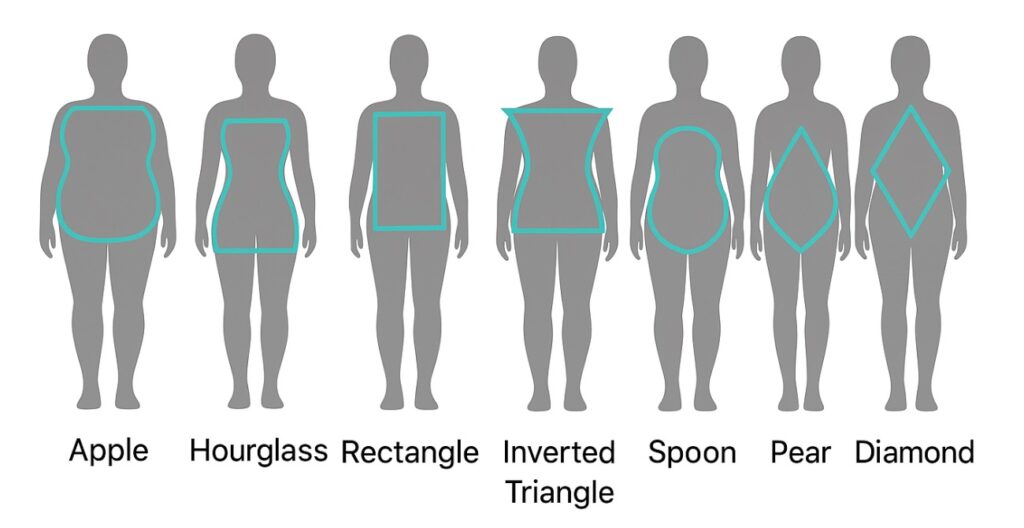A lot of people believe that losing weight is just about eating less and moving more. It sounds simple enough, but real life is rarely that straightforward. Body shape and weight loss are often closely linked, influenced by things like fat distribution, metabolism, and hormones.
You might have noticed that some people seem to lose weight easily while others find it more of a battle, despite similar efforts. That’s not just down to willpower. Science suggests our body types can have a real impact on how we store fat, and how we lose it too.
In this article, we’ll explore how body shape connects with weight loss and why personalising your approach could make all the difference.
What Are the Different Body Types?

Understanding your body type can help you create a plan that feels a little more natural and achievable, rather than fighting against it. Here’s a quick overview:
Apple-Shaped
- Tends to carry weight around the midsection.
- Focus: Improving blood sugar regulation, reducing visceral fat.
- Helpful approach: A balanced diet and moderate-intensity exercise, such as interval training under professional guidance.
Hourglass-Shaped
- Weight is distributed evenly across the upper and lower body.
- Focus: Preserving muscle tone and overall balance.
- Helpful approach: Strength training combined with a balanced intake of protein, carbohydrates, and healthy fats.
Pear-Shaped
- Stores fat predominantly in the hips, thighs, and buttocks.
- Focus: Supporting lower body strength while managing fat accumulation.
- Helpful approach: Resistance training plus cardio sessions can help improve body composition over time.
Rectangle-Shaped
- Minimal curves tend towards a faster metabolism.
- Focus: Building muscle for shape and strength.
- Helpful approach: Regular strength exercises with mindful nutrition to maintain lean body mass.
Inverted Triangle-Shaped
- Broader shoulders and chest compared to hips.
- Focus: Balancing proportions and maintaining muscle definition.
- Helpful approach: Targeted lower-body strength exercises paired with cardiovascular activities.
Spoon-Shaped
- A more exaggerated lower body fat distribution.
- Focus: Managing calorie intake while preserving muscle.
- Helpful approach: Tailored portion control strategies and resistance training.
Diamond-Shaped
- Carries weight around the abdomen with less overall muscle definition.
- Focus: Supporting metabolic health through sustainable lifestyle changes.
- Helpful approach: Low-impact exercise routines and an anti-inflammatory eating pattern.
Quick Note: Everybody’s body is a little different — these are general patterns, not strict rules. It’s always a good idea to speak to a healthcare provider before making significant changes.
Does Body Shape Influence Weight Loss?
It’s a common myth that everyone loses weight in the same way. In reality, body shape influences how the body stores — and sheds — fat.
How Genetics Shape Fat Distribution
Your genes can play a big part in determining whether fat settles around your hips, thighs, or midsection. This can, in turn, affect how quickly you notice changes when making healthy adjustments.
Are Some Body Types “Easier” for Weight Loss?
- People with an apple or inverted triangle shape might find early weight loss easier in general, but may face more stubborn belly fat due to factors like insulin sensitivity.
- Pear or spoon shapes often hold onto lower-body fat a little longer, even when overall weight drops.
- Rectangle and hourglass shapes tend to experience more even fat loss across the body.
Again, these trends are general. Personal health history, lifestyle, and habits often matter just as much, if not more.
Common Weight Loss Myths to Watch Out For
- Myth: You can “spot reduce” fat from specific areas with exercise.
Truth: Fat loss happens across the body, not just where you work out most. - Myth: Everyone should follow the same weight loss plan.
Truth: Personalising your nutrition and activity to your needs often gives better, safer results.
Hormones, Fat Storage, and Metabolism
Hormones are quietly working behind the scenes, affecting how your body stores and uses fat.
A Few Key Players:
- Insulin: Helps manage blood sugar. Imbalances can encourage more fat storage, particularly around the middle.
- Cortisol: Known as the stress hormone. Chronic stress may be linked to weight gain around the abdomen.
- Estrogen: Influences fat storage patterns, especially around hips and thighs.
- Leptin & Ghrelin: Regulate hunger and satiety signals.
How your body responds to these hormones can influence how easy or hard weight loss feels.
Exercise and Nutrition Tips by Body Type
While there’s no magic formula, certain patterns seem to help different body types:
- Apple, pear, diamond shapes: Benefit from strength training, moderate to high-protein diets, and interval-based cardio activities.
- Rectangle, inverted triangle shapes: May see better results by balancing strength and endurance workouts to build and preserve muscle mass.
- Hourglass, spoon shapes: Often do well with a mix of strength training and moderate-intensity cardio, focusing on stability and endurance.
Reminder: Before making any significant changes, it’s a good idea to speak with a qualified professional to make sure your approach is safe and tailored to you.
Body shape is just one piece of the weight loss puzzle — but it’s an important one. Recognising how fat storage, hormones, and metabolism interact with your unique build can help you make smarter, more sustainable choices.
Rather than chasing “perfect” outcomes, the real goal is to create habits that protect your overall health and support long-term well-being.
If you’re not sure where to start, speaking to a healthcare provider can help you map out the best approach for your needs. At WePrescribe, we’re here to support you with guidance that puts your health first, every step of the way.


